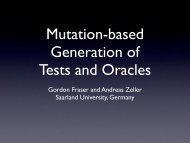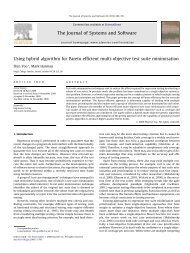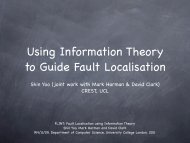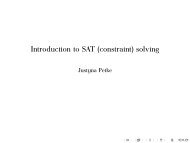Statistical Testing Using Automated Search - Crest
Statistical Testing Using Automated Search - Crest
Statistical Testing Using Automated Search - Crest
Create successful ePaper yourself
Turn your PDF publications into a flip-book with our unique Google optimized e-Paper software.
776 IEEE TRANSACTIONS ON SOFTWARE ENGINEERING, VOL. 36, NO. 6, NOVEMBER/DECEMBER 2010ACKNOWLEDGMENTSThe authors would like to thank Jose Carlos Maldonado andAuri M. R. Vincenzi for their assistance with the Proteum/IMmutation testing tool, Marie-Claude Gaudel for her discussionof statistical testing, and Hélène Waeselynck forclarifying the techniques used in her work with PascaleThévenod-Fosse and which inspired the research describedin this paper. This work is funded by Engineering andPhysical Sciences Research Council grant EP/D050618/1,SEBASE: Software Engineering by <strong>Automated</strong> SEarch.REFERENCES[1] P. Thévenod-Fosse and H. Waeselynck, “An Investigation of<strong>Statistical</strong> Software <strong>Testing</strong>,” J. Software <strong>Testing</strong>, Verification andReliability, vol. 1, no. 2 pp. 5-26, 1991.[2] P. Thévenod-Fosse, “Software Validation by Means of <strong>Statistical</strong><strong>Testing</strong>: Retrospect and Future Direction,” Dependable Computingfor Critical Applications, A. Avizienis and J. C. Laprie, eds., pp. 23-50, Springer, 1991.[3] P. Thévenod-Fosse, H. Waeselynck, and Y. Crouzet, “Software<strong>Statistical</strong> <strong>Testing</strong>,” Technical Report 95178, Laboratoire d’Analyseet d’Architecture des Systèmes du CNRS (LAAS), 1995.[4] P. Thévenod-Fosse and H. Waeselynck, “Statemate Applied to<strong>Statistical</strong> <strong>Testing</strong>,” Proc. Int’l Symp. Software <strong>Testing</strong> and Analysis,pp. 99-109, 1993.[5] M. Harman and B.F. Jones, “<strong>Search</strong>-Based Software Engineering,”Information and Software Technology, vol. 43, pp. 833-839,2001.[6] J. Clark, J.J. Dolado, M. Harman, R. Hierons, B. Jones, M. Lumkin,B. Mitchell, S. Mancoridis, K. Rees, M. Roper, and M. Shepperd,“Reformulating Software Engineering as a <strong>Search</strong> Problem,” IEEProc. Software, vol. 150, no. 3, pp. 161-175, 2003.[7] Y. Zhang, M. Harman, and S.A. Mansouri, “The Multi-ObjectiveNext Release Problem,” Proc. Genetic and Evolutionary ComputationConf., pp. 1129-1137, 2007.[8] E. Alba and F. Chicano, “Software Project Management withGAs,” Information Sciences, vol. 177, no. 11, pp. 2380-2401, 2007.[9] P. Emberson and I. Bate, “Minimising Task Migrations andPriority Changes in Mode Transitions,” Proc. 13th IEEE Real-Timeand Embedded Technology and Applications Symp., pp. 158-167, 2007.[10] M. Harman and L. Tratt, “Pareto Optimal <strong>Search</strong> Based Refactoringat the Design Level,” Proc. Genetic and Evolutionary ComputationConf., pp. 1106-1113, 2007.[11] C. Hao, J.A. Clark, and J.L. Jacob, “Synthesising Efficient andEffective Security Protocols,” Proc. Workshop <strong>Automated</strong> Reasoningfor Security Protocol Analysis, pp. 25-40, 2004.[12] P. McMinn, “<strong>Search</strong>-Based Software Test Data Generation: ASurvey,” Software <strong>Testing</strong>, Verification and Reliability, vol. 14, no. 2,pp. 105-156, 2004.[13] D. White, J.A. Clark, J. Jacob, and S. Poulding, “EvolvingSoftware in the Presence of Resource Constraints,” Proc.Genetic and Evolutionary Computation Conf., pp. 1775-1782, 2008.[14] M. Harman, “The Current State and Future of <strong>Search</strong> BasedSoftware Engineering,” Proc. 29th Int’l Conf. Software Eng. Future ofSoftware Eng., pp. 342-357, 2007.[15] J. Duran and S. Ntafos, “An Evaluation of Random <strong>Testing</strong>,” IEEETrans. Software Eng., vol. 10, no. 4, pp. 438-444, July 1984.[16] D. Hamlet, “When Only Random <strong>Testing</strong> Will Do,” Proc. First Int’lWorkshop Random <strong>Testing</strong>, pp. 1-9, 2006.[17] H. Zhu, P.A.V. Hall, and J.H.R. May, “Software Unit TestCoverage and Adequacy,” ACM Computing Surveys, vol. 29,no. 4, pp. 366-427, 1997.[18] M.J. Harrold, R. Gupta, and M.L. Soffa, “A Methodology forControlling the Size of a Test Suite,” ACM Trans. Software Eng. andMethodology, vol. 2, no. 3, pp. 270-285, 1993.[19] J.A. Jones and M.J. Harrold, “Test-Suite Reduction and Prioritizationfor Modified Condition/Decision Coverage,” IEEE Trans.Software Eng., vol. 29, no. 3, pp. 195-209, Mar. 2003.[20] S. Ntafos, “On Random and Partition <strong>Testing</strong>,” ACM SIGSOFTSoftware Eng. Notes, vol. 23, no. 2, pp. 42-48, 1998.[21] DO-178B, Software Considerations in Airborne Systems and EquipmentCertification, Radio Technical Commission for Aeronautics, 1992.[22] Defence Standard 00-55(PART2)/Issue 2, Requirements for SafetyRelated Software in Defence Equipment, Part 2: Guidance, Ministryof Defence, 1997.[23] P. Thévenod-Fosse and H. Waeselynck, “Towards a <strong>Statistical</strong>Approach to <strong>Testing</strong> Object-Oriented Programs,” Proc. IEEE Ann.Int’l Symp. Fault Tolerant Computing, pp. 99-108, 1997.[24] A. Denise, M.-C. Gaudel, and S.-D. Gouraud, “A Generic Methodfor <strong>Statistical</strong> <strong>Testing</strong>,” Technical Report 1386, Laboratoire deRecherche en Informatique (LRI), CNRS—Univ. de Paris Sud,Apr. 2004.[25] N. Baskiotis, M. Sebag, M.-C. Gaudel, and S. Gouraud, “AMachine Learning Approach for <strong>Statistical</strong> Software <strong>Testing</strong>,”Proc. Int’l Joint Conf. Artificial Intelligence, pp. 2274-2279, 2007.[26] R.P. Pargas, M.J. Harrold, and R.R. Peck, “Test-Data Generation<strong>Using</strong> Genetic Algorithms,” Software <strong>Testing</strong>, Verification andReliability, vol. 9, pp. 263-282, 1999.[27] B. Korel, “Automatic Software Test Data Generation,” IEEE Trans.Software Eng., vol. 16, no. 8, pp. 870-879, Aug. 1990.[28] N. Tracey, J. Clark, and K. Mander, “<strong>Automated</strong> Program FlawFinding <strong>Using</strong> Simulated Annealing,” ACM SIGSOFT SoftwareEng. Notes, vol. 23, no. 2, pp. 73-81, 1998.[29] N.J. Tracey, “A <strong>Search</strong>-Based <strong>Automated</strong> Test-Data GenerationFramework for Safety-Critical Software,” PhD dissertation, Dept.of Computer Science, Univ. of York, 2000.[30] J. Wegener, A. Baresel, and H. Sthamer, “Evolutionary TestEnvironment for Automatic Structural <strong>Testing</strong>,” Information andSoftware Technology, vol. 43, pp. 841-854, 2001.[31] S. Forrest and M. Mitchell“Relative Building-Block Fitness and theBuilding Block Hypothesis,” Foundations of Genetic Algorithms 2,D.L. Whitley, ed., pp. 109-126, Morgan Kaufmann, 1993.[32] M. Galassi et al., GNU Scientific Library Reference Manual, seconded. Network Theory, 2006.[33] “JDK 1.4 Demo Applets.” http://java.sun.com/applets/jdk/1.4/index.html, 2010.[34] “WCET Analysis Project.” http://www.mrtc.mdh.se/projects/wcet/benchmarks.html, 2010.[35] M.E. Delamaro and J.C. Maldonado, “Proteum/IM 2.0: AnIntegrated Mutation <strong>Testing</strong> Environment,” Mutation <strong>Testing</strong> forthe New Century, pp. 91-101, Kluwer Academic Publishers, 2001.[36] T.J. DiCiccio and B. Efron, “Bootstrap Confidence Intervals,”<strong>Statistical</strong> Science, vol. 11, no. 3, pp. 189-212, 1996.[37] N.L. Leech and A.J. Onwuegbuzie, “A Call for Greater Use ofNonparametric Statistics,” technical report, US Dept. of Education,Educational Resources Information Center, 2002.[38] F. Wilcoxon, “Individual Comparisons by Ranking Methods,”Biometrics Bull., vol. 1, no. 6, pp. 80-83, 1945.[39] A. Vargha and H. Delaney, “A Critique and Improvement of theCL Common Language Effect Size Statistics of McGraw andWong,” J. Educational and Behavioral Statistics, vol. 25, no. 2,pp. 101-132, 2000.[40] E.W. Weisstein, “‘Bernoulli Distribution.’ From MathWorld—AWolfram Web Resource.” http://mathworld.wolfram.com/BernoulliDistribution.html, 2010.[41] E.W. Weisstein, “‘Geometric Distribution.’ From MathWorld—AWolfram Web Resource.” http://mathworld.wolfram.com/GeometricDistribution.html, 2010.[42] A.E. Eiben, Z. Michalewicz, M. Schoenauer, and J.E. Smith,“Parameter Control in Evolutionary Algorithms,” ParameterSetting in Evolutionary Algorithms, F.G. Lobo, C.F. Lima, andZ. Michalewicz, eds., vol. 54, pp. 19-46, Springer, 2007.[43] W.J. Gutjahr and G.C. Pflug, “Simulated Annealing for Noisy CostFunctions,” J. Global Optimization, vol. 8, no. 1, pp. 1-13, 1996.[44] S. Rana, D.L. Whitley, and R. Cogswell, “<strong>Search</strong>ing in the Presenceof Noise,” Parallel Problem Solving from Nature, pp. 198-207,Springer, 1996.[45] H.-G. Beyer, “Evolutionary Algorithms in Noisy Environments:Theoretical Issues and Guidelines for Practice,” Computer Methodsin Applied Mechanics and Eng., vol. 186, pp. 239-267, 2000.[46] S. Markon, D.V. Arnold, T. Bäck, T. Beielstein, and H.-G. Beyer,“Thresholding—A Selection Operator for Noisy ES,” Proc. 2001IEEE Congress on Evolutionary Computation, pp. 465-472, 2001.[47] S. Yoo and M. Harman, “Pareto Efficient Multi-Objective TestCase Selection,” Proc. 2007 Int’l Symp. Software <strong>Testing</strong> and Analysis,pp. 140-150, 2007.[48] K. Lakhotia, M. Harman, and P. McMinn, “Handling DynamicData Structures in <strong>Search</strong> Based <strong>Testing</strong>,” Proc. Genetic andEvolutionary Computation Conf., pp. 1759-1766, 2008.







